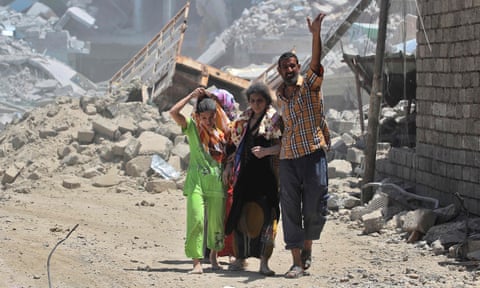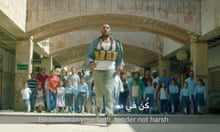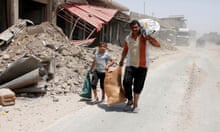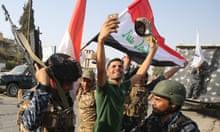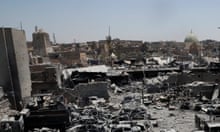In June 2014, when the leader of Isis, Abu Bakr al-Baghdadi, declared a global caliphate, he did it from Mosul, Iraq’s second city. Isis rapidly expanded its territory in Iraq and Syria throughout that year, but has since been gradually pushed back, partly due to US-led airstrikes. Losing Mosul now could spell the end of the jihadi group’s ability to control large swaths of Iraq.
The long-awaited operation to take back Mosul began on 16 October, involving a coalition of more than 30,000 troops drawn from Iraqi army forces, Kurdish peshmerga fighters and Shia militias, supported by airstrikes from a US-led coalition. Turkish forces are also involved despite Iraqi government opposition.
Around 6,000 Isis fighters could be holed up in the city among more than a million civilians. It was agreed that only the Iraqi army would enter Mosul, due to fears its mainly Sunni inhabitants would see the Kurdish and Shia forces as too partisan.

Week one: multi-pronged attack begins
After one week, progress was made to the north, south and east of Mosul despite Isis using a variety of defensive tactics. Advancing forces faced roadside bombs, dug-in snipers, fleets of suicide car bombs and oil fire haze. The jihadis also launched diversionary attacks, most significantly in Kirkuk. It was also reported that Isis fighters were forcing people from the countryside into the city to use as human shields. Most progress was made east of the city, where Iraqi forces took the baton from the peshmerga who overwhelmed several villages in the first few days of fighting. A southern push by Iraqi army troops and Shia militias lagged behind the faster-moving eastern axis.
Week two: city limits reached
Iraqi special forces reached Mosul’s eastern edge on 31 October after just over two weeks of fighting along the main Irbil road. Footholds were established in districts such as Gogjali and Karama before the westward offensive resumed on 4 November in the face of heavy Isis resistance. Advancing troops are expected to face a brutal street fight in heavily mined terrain, with booby-trapped bridges and Isis fighters concealed in tunnels. This may yet extend the operation’s length to the months forecast in many initial estimates.
Week six: awaiting a breakthrough
Anti-Isis forces have effectively surrounded Mosul after more than six weeks of fighting but most observers expect the battle to last into 2017. The only Iraqi units inside the city are making slow progress in eastern districts, where Isis forces are fighting hard in areas where large numbers of civilians are still present. About 70,000 refugees are living in camps mainly to the north-east of Mosul but their numbers could swell if conditions deteriorate further inside the city. Fighting has cut off water supplies for about 650,000 people and the UN has said a siege-like situation is developing. Food supplies have dwindled since Shia militia cut off the main corridor to Isis territory in Syria but the Iraqi government has discouraged them from taking the strategic town of Tel Afar, which may have raised sectarian tensions with its mainly Turkoman residents.
Week 14: Iraqi forces near to splitting city
A pincer movement by the Iraqi government’s counter-terrorism service is aiming to clear Isis fighters from the east bank of the Tigris. Elite CTS forces seized control of the large Mosul University complex, which Isis fighters used as a base, on 15 January. Meanwhile, other units have pushed north along the river after establishing their first bridgehead on 8 January. The offensive was effectively relaunched at the end of 2016 when troops from other positions were redeployed, along with US special forces, to bolster the main lines of attack in east Mosul. This enabled the CTS to advance after struggling for weeks to move beyond suburbs reached earlier in the operation.
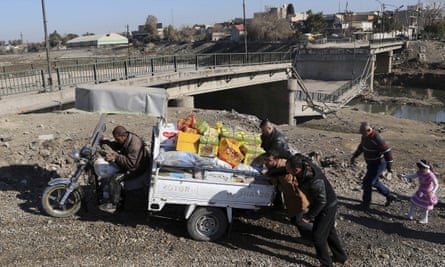
Iraqi forces now control the eastern side of three bridges over the Tigris but none are currently operational. All river crossings were partially destroyed by US-led airstrikes aimed at hampering Isis logistics but will now need repairing for an assault on the densely populated west bank where heavy Isis resistance and several more months of fighting likely awaits.
Week 20: airport assault drives battle for the west
Iraqi government forces took control of most of Mosul airport on 23 February, meeting their first key objective for retaking the western half of the city from Isis. The operation was launched on 19 February several weeks after Iraqi forces established complete control of eastern Mosul. Isis fighters sabotaged the runway last year but Iraqi forces will use the large site as a base to push north into residential districts and towards symbolic locations such as Mosul’s great mosque. A difficult fight is expected in these densely populated, built-up areas where tanks and armoured vehicles will be unable to operate and Isis is likely to use human shields and deploy ambushes and suicide bombers.
Up to 750,000 civilians may still be trapped inside west Mosul, with fuel and food supplies dwindling and drinking water and electricity scarce. The UN says about 160,000 civilians have been displaced since the battle for Mosul began in October and aid organisations are preparing for another exodus as the offensive enters its latest stage.
Week 25: west Mosul offensive resumes
31 March 2017: Most of the centre of west Mosul remains under Isis control after a deadly airstrike by the US-led coalition highlighted the difficulty of fighting in densely populated areas. Iraqi military leaders were forced to temporarily halt operations amid international condemnation of the raid, which killed at least 150 people in the frontline district of Mosul Jadida on 17 March. Isis fighters are said to have encouraged people to take shelter in three buildings that were then destroyed by coalition aircraft. Such jihadi tactics are likely to continue as Iraqi forces converge through populous neighbourhoods towards the symbolic Grand Nuri mosque where Isis declared its caliphate in 2014.
The two-pronged push into Mosul’s western districts began with the capture of Mosul airport in February. Iraqi units moving north along the Tigris river made key gains on 7 March by capturing Mosul’s municipal centre, central bank and museum. An advance to the west of the old city that eventually captured Mosul Jadida has now resumed as investigations continue into the 17 March airstrike.
Week 37: Isis destroys Great Mosque as Iraqi forces close in
The 12th-century Great Mosque of al-Nuri was blown up as Iraqi forces continued a concerted assault on remaining Isis positions in the old city. The mosque’s renowned leaning minaret, which was a highly visible and hugely symbolic target for advancing Iraqi forces, abruptly disappeared from the city’s skyline after more than eight hundred years. Footage suggested it had been destroyed by explosives deliberately placed at its base. The US military denied Isis claims it had hit it in an airstrike.
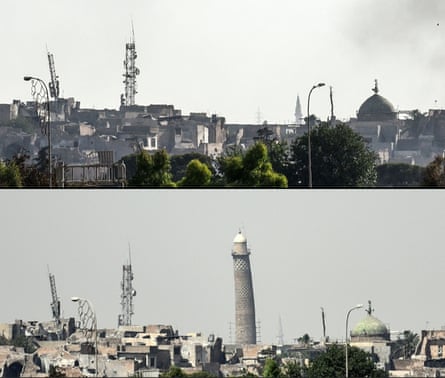
The significance of the mosque to Isis was that it was where its leader Abu Bakr al-Baghdadi had in June 2014 declared a “caliphate”. The Iraqi prime minister, Haider al-Abadi, said its destruction was now a “declaration of their defeat”. But such an outcome may yet be weeks away given the months of arduous street-fighting required to reduce Isis’s control to a small portion of the old city and their ranks to 300 militants, compared with almost 6,000 at the start of the offensive in October.
